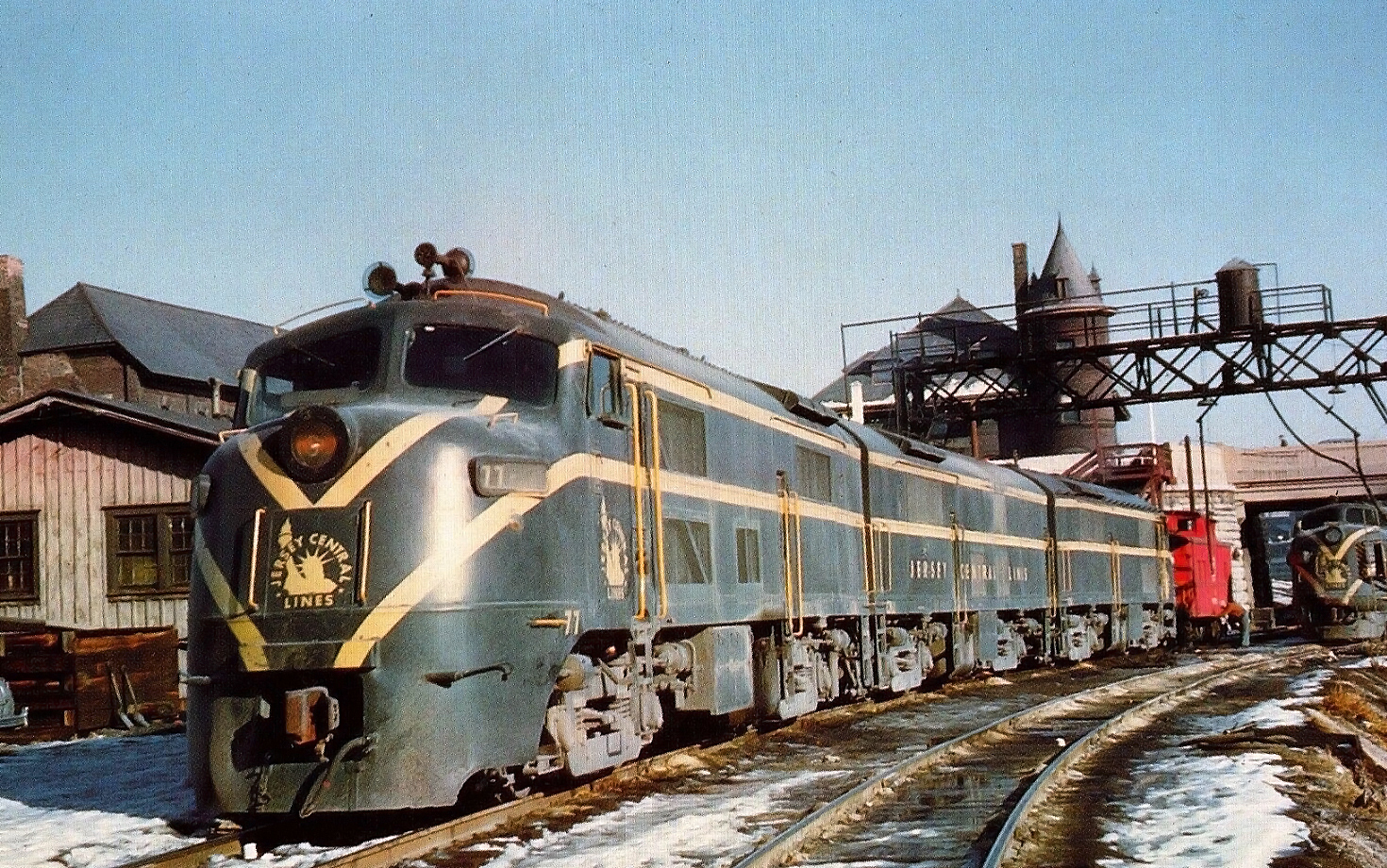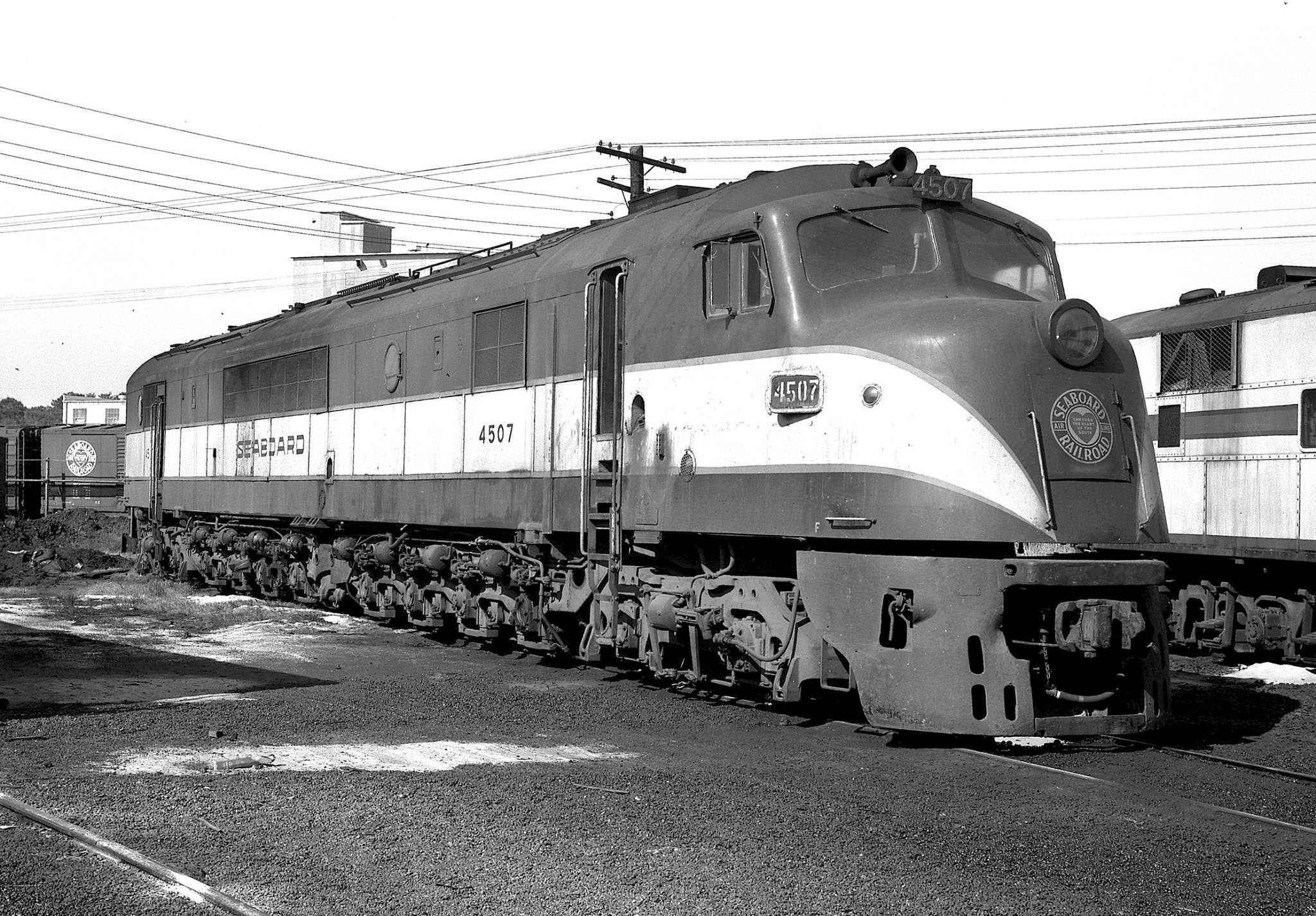Baldwin's "Baby Face" Carbody: Its Early Cab Models
Last revised: June 1, 2023
By: Adam Burns
Perhaps the most interesting diesel carbody to ever roll off the assembly line was Baldwin's Babyface variant. It was the builder's initial cab design and used on cataloged models DR-4-4-1500, DR-6-4-1500, DR-6-4-2000, and the DR-12-8-1500/2 ("Centipede").
The design gained its nickname thanks to its low, sloped nose and large front windows. It was a poor look that is often regarded as a cheap knock-off of Electro-Motive's popular E and F series cab units.
In an era when looks mattered, Baldwin realized it needed to redesign the styling of its cab units and eventually hired an outside firm.
This "Sharknose" carbody proved far more successful from an aesthetics standpoint, and Baldwin wound up selling far more locomotives shrouded as Sharks than it ever did with the Babyface. Because so few were ever built, no Baby Face models are known to be preserved today.
Photos
 An A-B-A set of Jersey Central DR-4-4-1500's, sporting the "Baby Face" carbody, layover at Scranton, Pennsylvania during January of 1961. Richard Wallin photo.
An A-B-A set of Jersey Central DR-4-4-1500's, sporting the "Baby Face" carbody, layover at Scranton, Pennsylvania during January of 1961. Richard Wallin photo.Overview
While the Baldwin Locomotive Works struggled to carve a niche for itself in the diesel locomotive market it found cab units especially difficult to sell.
There were three primary reasons for this:
- Firstly, Baldwin waited nearly ten years after EMD released its initial E and F models in the latter 1930s.
- Secondly, the company's early prime movers were troublesome and difficult to maintain.
- Thirdly, the Babyface look, itself, was very unpopular with railroads. Why buy a "cheap" look-alike of a locomotive already on the market and much more reliable?
The very first model to feature the Babyface design was the unique DR-12-8-1500/2 (or DR12-8-3000), "Centipede", released in 1945.
Its origins can actually predate World War II when Baldwin came up with a locomotive that would operate with eight, 750 horsepower engines for a total of 6,000 horsepower.
Reception
It was fascinating concept which would allow these power plants to be swapped in and out as needed. Unfortunately, Baldwin soon realized it was too powerful as a single locomotive and lacked the redundancy of three-locomotive, A-B-A sets offered by Alco and EMD in 2,000 horsepower configurations.
The monstrous Centipede had its issues but was actually more successful than historical texts often mention:
- Its prime mover did have issues but Baldwin was working to correct these problems.
- PRR's complaint of tracking problems was the result of using the locomotive in a capacity for which it was not intended.
- PRR's secondary complaint of brake-shoe replacement was the result of not having proper facilities.
The Centipedes were designed for passenger service where they could provide high tractive effort, high speeds, and a smooth ride.
They performed well in this capacity and actually drew interest from several railroads, including the Rio Grande which contemplated using a dual-powered version over parts of its main line in Colorado and Utah that were to be electrified.
This fascinating concept was ultimately never adopted. Baldwin's first cataloged cab unit to feature the Babyface carbody was the DR-4-4-1500 freight model.
It sold poorly, as did the DR-6-4-1500 and DR-6-4-2000 (and their variants, like Jersey Central's double-ended model), designed for passenger service,
All were constructed in the late 1940s, just before the company released its Standard Line, which offered a more reliable prime mover and redundant classification system.
When Baldwin contracted with Hadley, Ryder & Pedersen for a complete carbody redesign the company enjoyed more success with these models, and the later RF16.
Hadley, Ryder & Pedersen was also tasked with arranging the interior equipment, stress analysis of the carbody, and working with Baldwin in the final overall design.
 The most famous model to wear the "Baby Face" carbody was the DR-12-8-3000 "Centipede." Seen here is a builder's photo of new Seaboard Air Line #4500 circa 1947.
The most famous model to wear the "Baby Face" carbody was the DR-12-8-3000 "Centipede." Seen here is a builder's photo of new Seaboard Air Line #4500 circa 1947.The history of Baldwin in the diesel era is a fascinating look at a company still driven by quality but unable to correctly forecast the future market.
After more than a century of successfully manufacturing steam locomotives, Baldwin never dreamed cookie-cutter, out of the box diesels would ever replace the steam boiler.
Interestingly, the company dabbled in the gasoline and diesel-powered locomotive market as early as 1910 (gasoline) and 1925 (diesel), respectively.
In addition, it had collaborated with Westinghouse on early electrics in the late 19th century. Baldwin also manufactured a wide range of successful, main line electrics between 1910 and the 1930s, such as Pennsylvania's legendary GG-1.
 The Seaboard's fleet of Baldwins spent many years in service, as seen here with "Centipede" #4507 laying over between assignments at Jacksonville, Florida in 1960. Felix Brunot photo/Warren Calloway collection.
The Seaboard's fleet of Baldwins spent many years in service, as seen here with "Centipede" #4507 laying over between assignments at Jacksonville, Florida in 1960. Felix Brunot photo/Warren Calloway collection.Baldwin's 1,500 horsepower cab models featured the builder's 608SC, supercharged prime mover. All of Baldwin's cab models were offered with "B" units, although few railroads purchased it.
The DR-6-4-1500 and DR-6-4-2000 were both designed as passenger variants and meant to compete with the likes of EMD’s E series and American Locomotive’s PA.
There was also the one-off DR-6-2-1000/2 SC1 built for the Chicago & North Western. The unit utilized a single 606SC prime mover rated at 1,000 horsepower.
The rest of the carbody was designed to carry baggage or mail. It was yet another example of Baldwin building specialized variants. Another such one-off design was Jersey Central's double-ended 0-6-6-0 1000/2 and DRX-6-4-2000.
The CNJ acquired six in total to handle commuter operations in and out of its Communipaw Terminal located along the Hudson River waterfront in Jersey City. The double-ended design eliminated the need to turn the locomotives between runs.
Variants and Models
| Model Type | Units Built | Date Built | Horsepower |
|---|---|---|---|
| DR-4-4-1500 | 22 A Units/11 B Units | 1947-1948 | 1,500 |
| DR-6-4-1000 | 1 (C&NW Only) | 1948 | 1,000 |
| DR-6-4-1500 | 6 A Units/2 B Units | 1947-1948 | 1,500 |
| DR-6-4-2000 | 2 (GM&O Only) | 1947 | 2,000 |
| DRX-6-4-2000 "Dual Cab" | 3 (CNJ Only) | 1948 | 2,000 | DR-12-8-1500/2 or DR12-8-3000 (Centipede) | 54 | 1945-1948 | 3,000 |
Final Years
The DR-4-4-1500 model was built for CNJ, Missouri Pacific, and New York Central with a total of 22 A units and 11 B units constructed.
The Sharknose shrouding in the same model witnessed greater success but it was the RF16 that saw the most sales. The Baby Face design was mostly unsuccessful and all were retired by the 1960s as mentioned above.
In 1950 Baldwin was merged with the Lima-Hamilton Corporation to form Baldwin-Lima-Hamilton by parent Westinghouse Electric. This coincided with Baldwin releasing a new line of diesels, the Standard line.
Sadly, management wanted to continue building locomotives and refine its product but Westinghouse pulled the plug. It is truly interesting to wonder if Baldwin would have been successful thanks to its more than 120 years in the business at that time.
By comparison, it took General Electric nearly 20 years of refining its own stand-alone road-switchers to finally surpass Electro-Motive as the industry's leader in locomotive manufacturing.
Sources
- Kirkland, John F. Diesel Builders, The: Volume Three, Baldwin Locomotive Works. Pasadena: Interurban Press, 1994.
- Pinkepank, Jerry A. Diesel Spotter's Guide. Milwaukee: Kalmbach Publishing Company, 1967.
- Solomon, Brian. Baldwin Locomotives. Minneapolis: Voyageur Press, 2009.
- Solomon, Brian. American Diesel Locomotive, The. Osceola: MBI Publishing, 2000.
SteamLocomotive.com
Wes Barris's SteamLocomotive.com is simply the best web resource on the study of steam locomotives.
It is difficult to truly articulate just how much material can be found at this website.
It is quite staggering and a must visit!
